




Key Takeaways
- Skim passages, don’t overread—let the questions guide where to focus.
- Use trends in graphs to predict, eliminate, and answer confidently.
- Save Conflicting Viewpoints for last to manage time and mental energy.
In an earlier blog, we used historical data to show that scoring well in the ACT Science section is slightly more challenging as compared to scoring in other sections. Thankfully, realistic strategies for the ACT Science section can help overcome this.
Students and educators agree that the ACT Science section is a paradox — the section is not so much about Science as it is about drawing valid inferences from the given passages and data. In fact, it’s reading comprehension, because students need to make valid interpretations from the passages, charts, or tables.
This blog covers actionable ACT Science strategies. We discuss how to time passages, how to correctly interpret graphs and tables, and how to best use your test-prep material.. Not just that, our ACT Science section tips also explain what to avoid — “rabbit-hole thinking, for instance.”
So let’s begin!
Understanding the ACT Science Section Structure
Before we discuss any section-specific tips, let’s fully understand the section: time, types of passages, and types of questions. And we’ll end with an important observation that might change the way you look at this section.
ACT Science section overview
Questions
The Science section has 40 questions to be answered in 35 minutes. That means, each question gets an average of 52 seconds. These questions are spread across 6 to 7 passages. Roughly, that comes to about 5 questions per passage.
Passages and their questions
Out of the seven passages, students will see two passages that focus on data representation. Here, students will be required to interpret graphs and tables.
Three passages revolved around research summaries. Each passage details some scientific experiments conducted. It could cover sample size, methodologies, and findings of the experiments. The questions test the student’s ability to accurately understand what can and what cannot be concluded from the experiments.
Finally, there could be one passage which presents two conflicting viewpoints, again about scientific theories. For instance, one view would support the Big Bang theory while the other view would endorse the Steady State theory. Each question asks students to compare the two viewpoints, and spot what strengthens or weakens a theory.
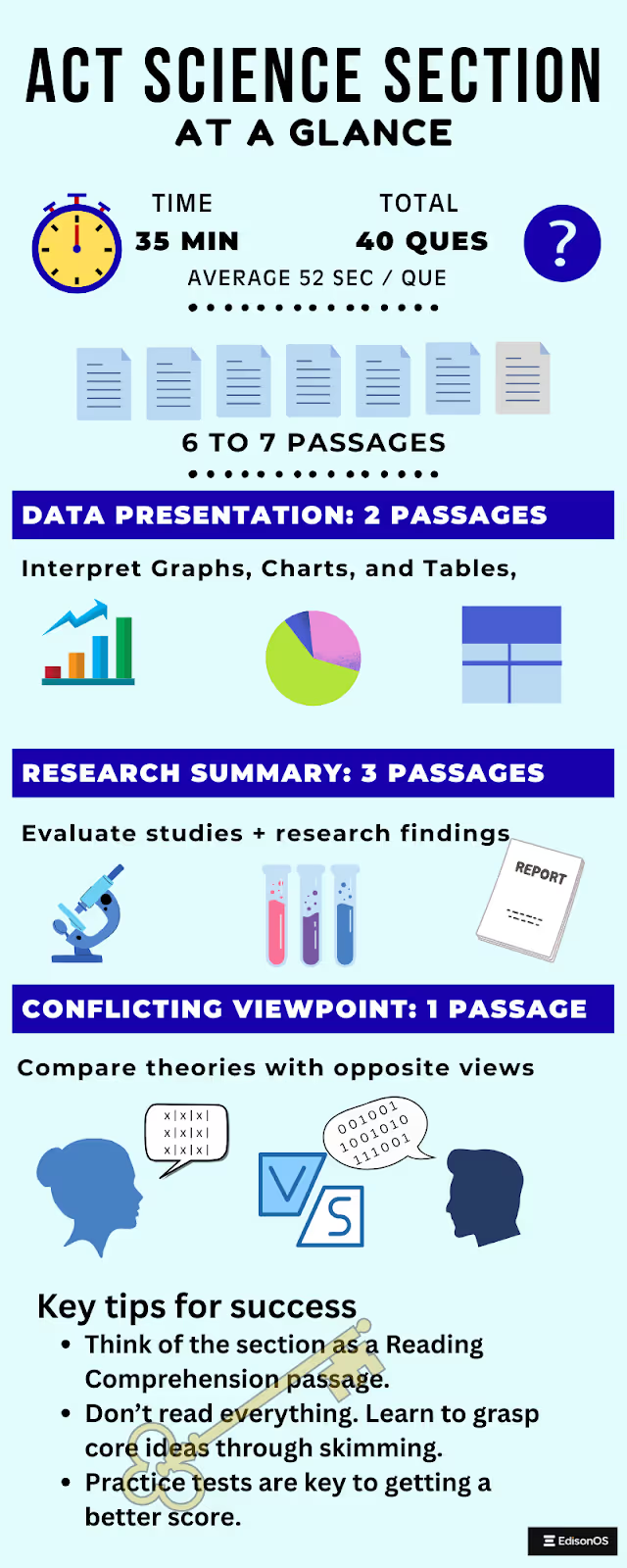
ACT Science section: Time management strategies
We’ll begin with simple, practical time management strategies to help students stay on track and maximize their score. No matter what scores they’re aiming for, have your students follow these ACT Science strategies:
1. Discipline: No more than 5 minutes per passage
As we’ve already mentioned, the ACT Science section allows 35 minutes for six to seven passages - that’s about 5 minutes per passage. So the first rule to never forget is: Do not spend more than 5 minutes in any passage. This will make sure students get a shot at every question without having to rush through towards the end.
2. Sequence: Conflicting Viewpoint passage should be the last
So here’s one of the most practical ACT science section tips: Save the Conflicting Viewpoint passage for the last. That’s simply because this passage requires closer reading than the other types of passages, making its questions appear slightly more challenging. Attempting other questions before this will build confidence in students to tackle these questions later on.
3. Style: Skim, skip, and return
Reading everything carefully can be a trap; students should know they will do just fine skimming instead. Make them practice to scan the intro and the figures, and then head right into questions. The questions will also tell what parts of the passages are more important, so your students can always revisit the passage. And if the questions sound tricky, students should make a guess, flag a question and move on.
4. Being objective: No overthinking beyond what’s given
One of the most important ACT science strategies is training your students so that their background knowledge doesn’t interfere with what’s given the passage and its data. It’s like going down the rabbit hole trying to make outside connections or assume things that aren’t stated. Students should just trust what’s given and answer accordingly.
5. Eliminate: Drop choices intelligently
There’s no way to be 100% sure of the answer, and that’s okay. What matters is narrowing down the choices. Eliminate answers that don’t match the graph, contradict the passage, or just don’t make sense. Even when guessing, students have a much better chance of landing the right choice.
6. Track time with checkpoints and adjust as needed
Instead of watching the clock anxiously, set internal checkpoints. For example, aim to finish three passages by the 17-minute mark. If you're ahead, great; you’ve got buffer time. If you're behind, now you know to speed up a bit. These checkpoints give you more control over your timing and help you avoid panic in the last few minutes.
Mini tips for time-management
7. Budget slightly more time for Conflicting Viewpoints
Because it's more reading-heavy, plan for 6–7 minutes instead of the usual 5 to avoid rushing.
8. Use logical elimination when returning to hard questions
Narrow down options by spotting contradictions or irrelevant choices to make faster, smarter guesses.
9. Simulate exam conditions regularly to build timing endurance
Practice full sections under timed, distraction-free settings to develop real test pacing and stamina.
10. Use timing checkpoints (e.g., 12 questions by 10 mins, 24 by 20 mins, etc.)
Setting mini-deadlines helps you stay on pace and avoid a last-minute time crunch.
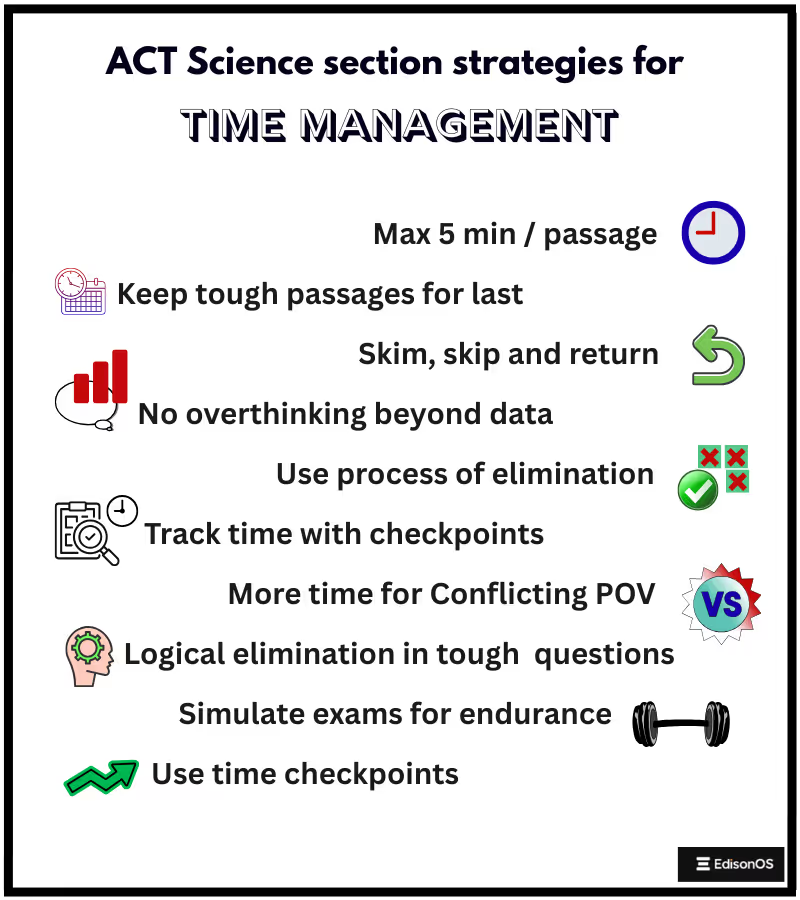
Mastering Data Representation passages in the ACT Science section
When it comes to the ACT Science section, Data Representation passages are often the most approachable if you know how to tackle them. Here, we’ll walk you through key ACT Science strategies that will help you read graphs, spot patterns, and answer questions with confidence.
1. Reading graphs and tables efficiently
The heart of any Data Representation passage is its visuals: graphs, tables, and charts. One of the most useful tips is to train students to “read” these figures like you read text. Start with titles, then scan the axes or columns, and check for footnotes or legends.
This saves time and helps quickly locate the right part of the figure when answering questions. Practicing this habit can shave precious seconds off every question.
2. Understanding axes, units, and scales
Every graph comes with a set of axes, and understanding them is non-negotiable. Always check what each axis represents, the units used (e.g., seconds, degrees, grams).
One of the common Science ACT tips is to watch out for graphs with uneven scales. Although not very common, they can easily make students get multiple answers wrong. If you’re comparing values or identifying changes, misreading the scale can lead to the wrong answer, even if your logic is sound.
3. Spotting trends and patterns quickly
Instead of getting stuck in the weeds, look for the big picture. Does the graph show an upward trend? A sudden dip? A repeating cycle? Recognizing these patterns can help you predict values, answer “what if” questions, and eliminate wrong choices fast.
It’s important for students to mentally summarize what a graph is “saying” before diving into the questions. The quicker students can interpret the trend, the more time they can save.
4. Common graph types on the ACT
Practice and familiarity lead to speed. On the ACT, line graphs, bar charts, scatter plots, and data tables are quite common, but each type has its own quirks. For instance, scatter plots often require students to estimate a line of best fit, while bar graphs demand quick comparisons. Again, the kind of inferences you can make from tables are different from those you can make from a line-graph.
One of the simplest but most effective science ACT strategies is to practice with all graph types beforehand so you’re not figuring out how to read the format during the test.
5. Practice strategies using mock tests
Have students use official ACT Science practice tests or reliable prep materials to simulate the test environment. Focus on accuracy first, then on timing. Track the time they spend on each passage and question.
A simple yet very powerful way to boost scores using mock ACTs is to make students review the wrong answers, or the answers they got right purely by guesswork. Better still, have them go through questions they got right but found tricky. That’s one of the smartest and most efficient ways to score well.
6. Skim the passage first; dive into data only when needed
In Data Representation passages, the text is often short and mostly introductory. Explain to your students why they needn’t worry too much about every detail up front. Instead, have them skim it to get a general idea, then jump into the figures. They may go back to the text if a question asks something that’s not visually available.
This is one of those science ACT tips that helps test-takers stay focused on what matters most:interpreting data to answer questions quickly and correctly.
Mini tips for the data presentation passages
7. Use trends to extrapolate or interpolate missing data points
Estimate values by extending or filling in data based on the overall pattern shown in the graph.
8. Break down compound graphs and read one trend at a time
Focus on one variable or data line at a time to avoid confusion in complex multi-line or multi-axis graphs.
9. Know which is a independent variable and which is dependent
Determine which variable is being changed (independent) and which one is being measured (dependent) to understand the relationship shown in the data.
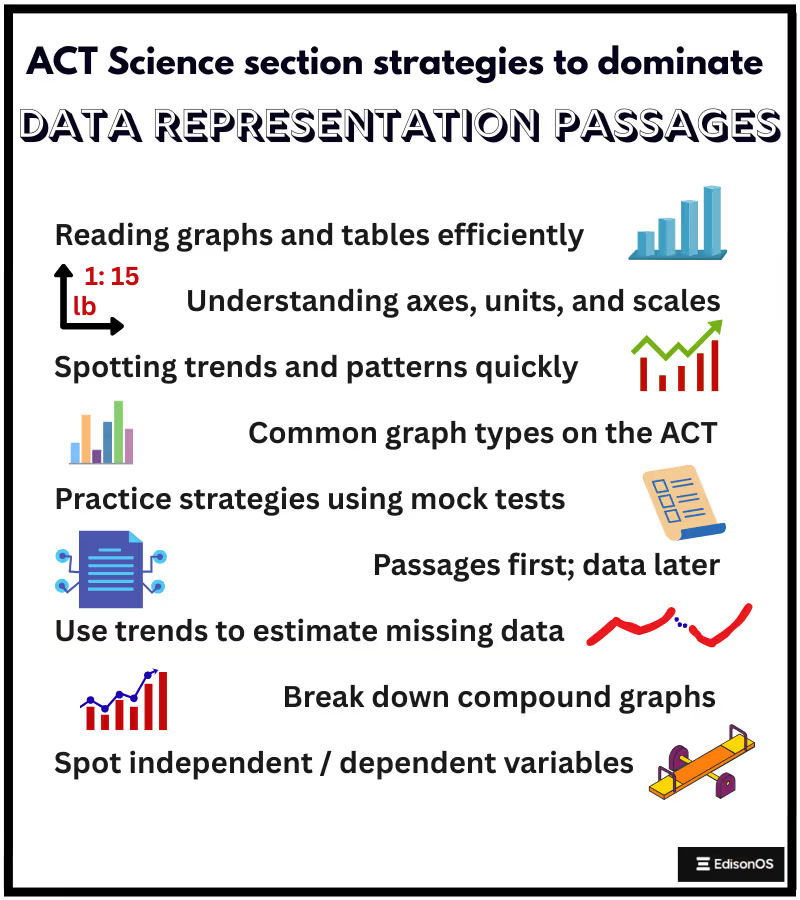
Research Summary passages mastery
In this section, we’ll dive into how you can help students master the Research Summary passages in the ACT Science section. These passages test how well test-takers understand experiments, data, and conclusions.
1. Understanding experimental design
One of the most effective ACT Science strategies is learning to quickly spot how an experiment is structured. What’s being tested? What’s being measured? Once a student understands the setup, the rest of the passage makes much more sense.
The focus should be on spotting the hypothesis, procedure, and how the experiment was carried out.
2. Identifying variables (Independent vs. Dependent)
Every experiment has variables: the independent variable is what scientists change, and the dependent variable is what they observe or measure. Then there’s something called the Control Group (where no changes are made) and the Experimental Group (where some changes are introduced, e.g. a new anti-asthma drug is administered).
Recognizing these quickly can help students answer many Science ACT tips-related questions accurately. Also, don't ignore constants, they give context and eliminate confusion.
3. Comparing multiple experiments
Many Research Summary passages include two or three experiments. Look for what’s different and what stays the same across them. Are they testing the same thing in a new way? Are the results consistent or contradictory? Does any experiment have restrictions that will make generalizing the results nearly impossible? As an ACT tutor, guide your students for the finer points they might otherwise miss.
4. Know common question patterns
Coach your students to spot recurring question types, like what was the purpose of the experiment, what would happen if a variable changed, which result supports a given conclusion, and so on. Once they’re familiar with these patterns, their brain can go into autopilot for certain formats. Practicing these common types helps them work faster and with more confidence.
5. Using EdisonOS platform for targeted practice
The EdisonOS ACT practice tests let you zero in on Research Summary passages and question types. You can track your accuracy, filter by topic, and get detailed explanations that mirror the real ACT science section.
Targeted practice here helps reinforce all the ACT Science strategies we’ve covered. More importantly, it saves students from drowning in random prep material that may have limited relevance to the ACT test, at best.
6. Know the purpose, method, and results of each experiment
Each experiment in the passage is like a mini-story. For the students, it’s important to know why it was done (the purpose), how it was done (the method), and what happened (the results). This breakdown simplifies even the messiest passages. Students may label these mentally so they can refer back without re-reading everything.
7. Extend or predict results based on trends
The ACT loves to ask, “What if we changed X?” These questions test, among other things, a student’s ability to understand trends and apply them logically.
Predicting outcomes is a top-tier skill and one of those ACT Science section tips that can make the test-taker feel like a fortune-teller... or, more accurately, really clever scientist.
8. Understand cause-effect logic (Correlation vs. Causation)
Just because two things happen together doesn’t mean one caused the other. The ACT might tempt students with a trap answer that confuses correlation with causation. It’s vital to stick to what the experiment actually tested and proved. If no controlled change was made, then no solid cause-effect conclusion can be drawn. Science logic beats guesswork any time.
Mini strategies for Research Summary passages
9. Avoid getting stuck on scientific jargon; focus on data and outcomes
Don’t let complex terms distract you. Instead, stick to what the data shows and what the results mean.
10. Reading study descriptions efficiently
Remind students to skim for what's tested, how, and the results. There’s no need to read it like a novel or win a Pulitzer!
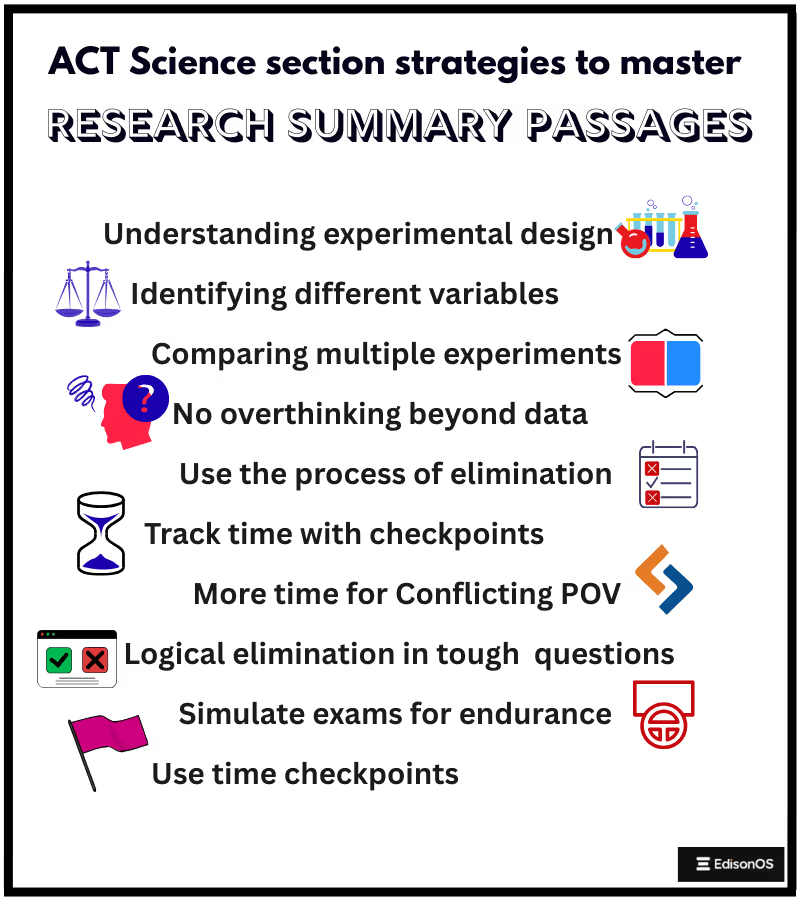
Conquering Conflicting Viewpoints passages
In this section, we’ll explore an area that often puzzles students the most: the Conflicting Viewpoints passage. Fortunately, with a few smart ACT Science strategies, students can turn this “battle of theories” into one of their strongest segments.
Why this passage type is often most challenging
Out of all ACT Science section tips you’ll hear, one stands out for this passage: be ready to read. Unlike other passages that feature charts and tables, this one is all text: technical, and often filled with scientists who just can’t agree.
Students will juggle multiple theories, some unfamiliar terms, and no visuals to break things down. It’s reading-heavy and requires test-takers to pay close attention to the broader aspect of why the two theories differ.
Reading strategy: Brief summaries for each viewpoint
Instead of trying to absorb every detail, read with a highlighter mindset. Right at the beginning of a new scientist’s viewpoint, students should ask themselves: What is this person arguing? What is their main point? These should be jotted down to summarize.
These summaries act like bookmarks and save you time when a question points you to specifics like, say, “Scientist 2’s claim about carbon levels.”
Identifying key differences between theories
Once students have summarized each viewpoint, ask them to compare the points like one would compare two opinions in a debate. What do they agree on, if anything? More importantly, how do their conclusions or assumptions differ?
Most of the questions will ask test-takers to evaluate the contrast between these viewpoints, not just understand them in isolation. Look for phrases like “unlike,” “in contrast,” or “however”; they turn out to be key while spotting differences.
Question types specific to conflicting viewpoints
Conflicting Viewpoints questions usually fall into three categories: identifying a viewpoint’s main idea, finding agreements or disagreements between scientists, and predicting how one scientist might respond to the other’s argument.
These aren't “find-the-data” questions; instead, they’re more like comprehension puzzles. Use the summaries and differences map to jump directly to the section you need, instead of rereading the entire text each time.
Time allocation for this section
Students will face only one Conflicting Viewpoints passage in the science ACT, but it often eats up more time than any other. So how to best time it?
The idea is to aim for 6–7 minutes here, and not let it spill over. Many test-takers prefer to tackle this passage last, once they’ve knocked out the quicker, data-driven ones. That way, one can enter this text-heavy task with maximum time flexibility and less stress.
Summing up the Conflicting Viewpoints passage
Conflicting Viewpoints may seem like a mini science debate with confusing jargon, but really, it's just reading smart, thinking logically, and knowing what each person is trying to say. Use these ACT Science strategies to keep the confusion in check and score high.
With practice, this passage won’t just be manageable, it might even be your student’s secret weapon. The only requirement is to be willing to read relatively dense material.
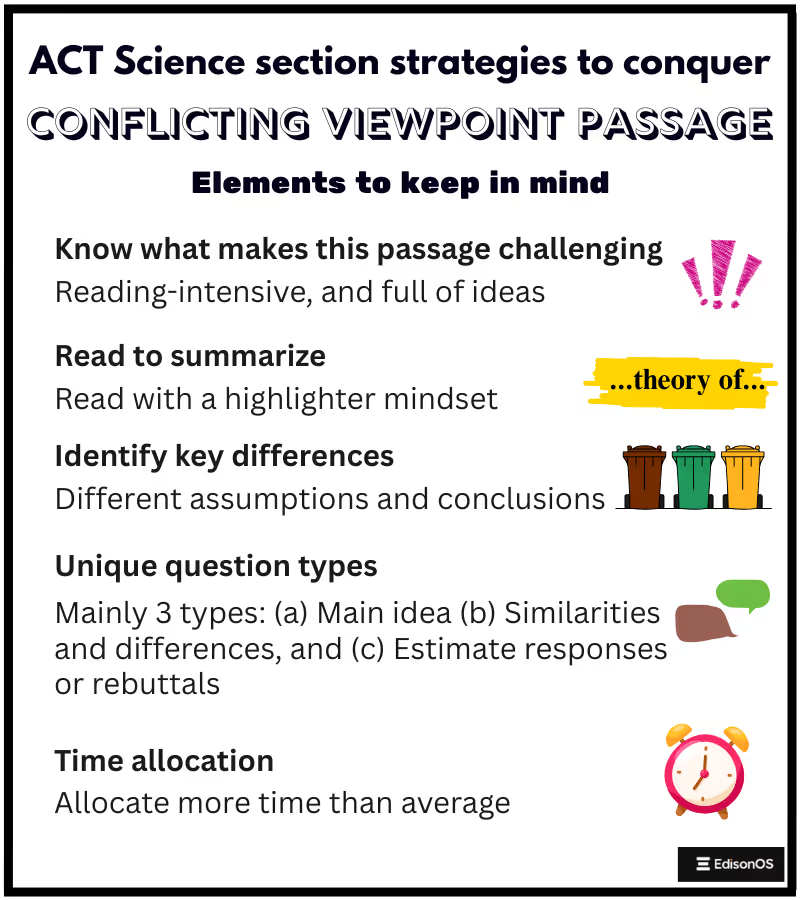
Question-specific strategies
These strategies are rooted in what kind of question the student sees, rather than what kind of passage it belongs to. These ACT Science section tips are designed to save time, reduce confusion, and boost accuracy.
1. Direct lookup questions: Use quick scanning techniques
Many ACT Science questions don’t require deep thinking. They just want test-takers to find a number, a trend, or a label. For these, learn to quickly scan tables, graphs, and diagrams. Look for axis labels, units, and figure titles. Practice pinpointing exactly where the answer is hiding instead of rereading everything.
2. Trend analysis questions: Recognize and extend patterns
Some questions ask students to describe how something changes across a graph or table. For these, it’s crucial to notice patterns. Is the line going up? Is it flattening? Is it irregular or zigzag?
Once the pattern is evident, it’s easy to predict what comes next. These ACT Science strategies are simple but powerful when practiced regularly.
3. Comparison questions: Cross-reference multiple sources
You’ll often be asked to compare experiments, results, or even scientists’ viewpoints. The trick is to focus on the variables: what stayed the same, and what changed.
There’s no need to remember everything. Instead, one may flip back and forth between charts and text to double-check. Cross-referencing is the test-taker’s best friend!
4. Prediction questions: Extrapolate from existing trends
When the ACT throws what looks like a curveball question (e.g. “What would happen if…”), it’s time to extrapolate. That means using the trend one already sees to make a reasonable guess about an unseen data point.
Whether it's a new temperature or a future time, trust the pattern identified. Ever experience finishing the sentence your best friend has only half uttered? Well, this isn’t different, it’s just that there’s graphs and tables here.
5. Experimental design questions: Know the setup
Many questions want to see if the student understands how a study or experiment was set up. That means identifying the independent variable (what changed), the dependent variable (what was measured), and the constants (what stayed the same).
Get familiar with this vocabulary, because it shows up again and again.
6. Cause and effect reasoning: Find the relationship
This isn’t just about memorizing facts. You’ll need to reason out how changing one part of an experiment affects the result. Is the effect direct or inverse? Does adding more of one thing increase the other or reduce it? Such Science ACT tips train logical thinking more than memory.
7. Inference-based questions: Connect the dots
These inference questions ask students to use whatever is there and figure out what’s not clearly stated. It’s like solving a puzzle where the final piece is invisible. Stay calm, go back to the passage, and find the clues.
Such ACT Science section tips are especially useful because they cover the broad question types you’ll see again and again. As you practice, try to identify which type each question belongs to and apply the right strategy accordingly. With a little repetition and a lot of common sense, you’ll start seeing your accuracy (and your confidence) go up.
Common mistakes to avoid in the ACT Science section
The ACT Science section can feel tricky, but many mistakes are easy to fix once one knows what to look out for. Below are the most common pitfalls, and tips on how to steer clear of them using smart ACT Science strategies.
Mistake 1: Reading the entire passage before jumping to questions
Why it’s a mistake:
Wastes precious time, because passages often have unnecessary information
Do this:
- Skim instead; focus on graphs, experiment details, and figure titles
- Let the questions guide what parts of the passage to dig into
Remember: One of the best ACT Science section tips is to read with purpose, not curiosity.
Mistake 2: Getting stuck on science content you don’t remember
Why it’s a mistake:
This isn’t a high school science test, so don’t stress over background facts
Do this:
- Focus on interpreting what’s given, not recalling what you once studied
- The tip that matter most: read graphs, compare trends, and analyze experiments
Remember:
Trust the passage and data; everything you need is already there.
Mistake 3: Spending too much time on one tough question
Why it’s a mistake:
One tricky question shouldn’t eat into your whole test
Do this:
- Flag it, move on, and come back if time allows
- All questions are worth the same, so max your score by grabbing the easy wins first
Remember:
Effective time management is one of the top strategies you must master.
Mistake 4: Misreading graph axes and labels
Why it’s a mistake: A tiny slip can lead to a wrong answer
Do this:
- Always check what each axis and unit represents before interpreting values
- Take a moment to understand legends, scales, and patterns before answering
Remember:
Slow down just enough to catch details.
Mistake 5: Not checking answers against data carefully
Why it’s a mistake:
Don’t pick what "sounds” right. Always verify everything against the passage
Do this:
- Eliminate choices that contradict the graph or experiment
- Even familiar-sounding facts can be traps if they’re not supported by the data
Remember:
Data-based logic beats instinct every time on the ACT Science test.
Mistake 6: Trying to understand every single detail upfront
Why it’s a mistake:
Leads to information overload and confusion
Do this:
- Skim with intention: titles, headings, and figure overviews are usually enough
- Only dive deep when the question demands it
Remember:
This is one of those science ACT tips that saves both time and mental energy.
Mistake 7: Answering based on memory, not the passage
Why it’s a mistake:
ACT Science tests reasoning, not textbook knowledge
Do this:
- Always refer back to the data or passage, even if the answer seems obvious
- Don’t assume you know the answer before double-checking
Remember:
Accuracy comes from evidence, not prior knowledge.
Mistake 8: Letting your gut override actual trends
Why it’s a mistake:
Seeing a familiar word doesn’t mean it's the right answer
Do this:
- Follow the trend, look for patterns, and make sure your answer is supported
- Visual evidence always wins over assumptions
Remember:
This mindset is a secret weapon.
Mistake 9: Treating all passage types the same way
Why it’s a mistake:
Conflicting Viewpoints, Data Representation, and Research Summaries each need a different approach
Do this:
- Skim conflicting views carefully, but focus more on data for the other two
- Adjust your reading strategy depending on the question style
Remember:
Smart science ACT tips include knowing when to shift gears.
Mistake 10: Guessing blindly when unsure
Why it’s a mistake:
Random guesses reduce your odds
Do this:
- Use process of elimination, even ruling out one or two helps
- If stuck, pick your “Letter of the Day” consistently for all guesses
Remember:
There’s no penalty for guessing, but there is power in guessing smart.
Avoiding these mistakes boosts the test-taker’s confidence, improves accuracy, and lands them a better score. The ACT Science section rewards quick thinking, smart reading, and a steady pace.
Effective practice strategies for ACT Science section
We are now at the final stage where we talk about the smart way of preparing for the ACT Science section in general. The proven strategies below will help your students improve steadily, avoid repeating mistakes, and build real test-day confidence.
Use timed practice sessions regularly
Simulate the 35-minute limit of the ACT Science section to build pacing skills. Practice with a timer and try completing 6 to 7 passages in one go. This helps you get used to the fast pace and sharpens your ability to focus under pressure.
It’s one of the most effective ACT science strategies for improving speed without sacrificing accuracy.
Analyze your mistakes systematically
Nothing helps students score better than the questions you got wrong. Make sure they don’t just glance at wrong answers and move on. Instead, dig into why they missed them. Was it a misread graph, a confusing question, or a flawed assumption? Keep an error log that includes the type of passage, the kind of question, and what went wrong.
Over time, this makes it easier to spot and fix recurring issues.
Build familiarity with all three passage types
Explain to your students the difference between Data Representation, Research Summaries, and Conflicting Viewpoints. Each type demands a slightly different approach. With regular exposure, students will soon start to recognize patterns in how questions are asked.
Mastering these formats helps students build passage-specific strategies and easily score better.
Emphasize why students need a tutor or mentor
Sometimes, students don’t know what they don’t know - they simply assume they ran out of time or made some silly mistakes. An ACT tutor like you can catch blind spots, explain tough questions, and tailor strategies to a student’s learning style.
Even a few sessions can give them personalized ACT Science section tips that they won’t find in books or free resources.
Track progress with simple metrics
Have students keep a spreadsheet or notebook to track their raw scores, number of questions attempted, and areas of difficulty. Seeing gradual improvement can boost their confidence.
This also helps them set clear requisite goals, like reducing time per passage or improving accuracy in Conflicting Viewpoints.
Review questions that students got right (because they were lucky)
Discuss this with students often: If you were uncertain but got lucky, treat it like a mistake. Go back and make sure you understand why the correct answer is right. This habit builds true confidence and cuts down careless errors.
Edison provides a granular-level insight for each question as well as for every answer choice. The adjoining screenshot shows a sample insight: what percentage of students got the question right, what was the average time students spent on this question, and what percentage of students selected which answer choice.
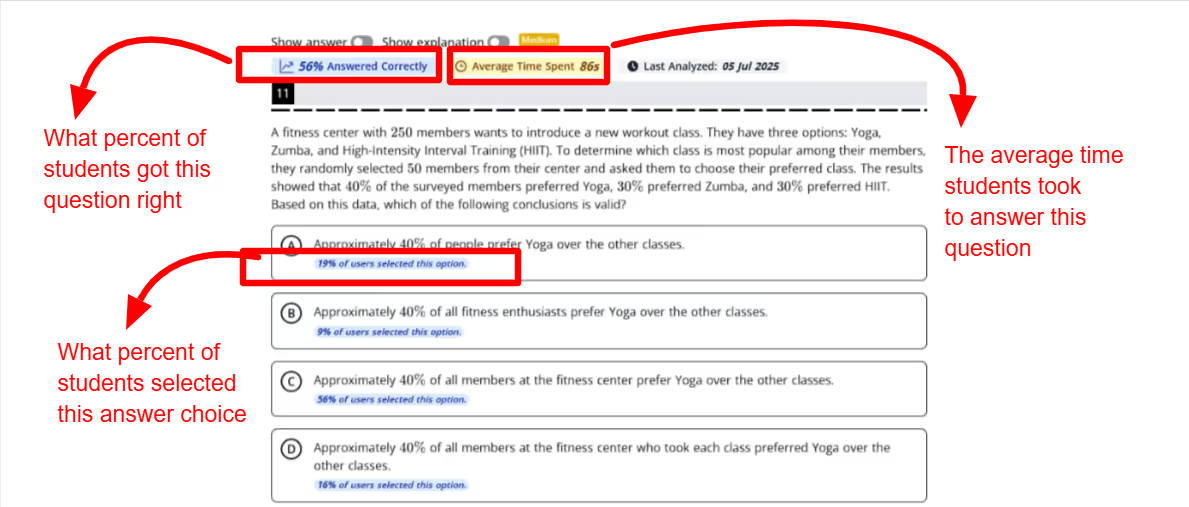
This can easily tell you if your student is taking longer than the average or is falling for the same incorrect answer choice as many others did.
Practice under real test conditions, often
Find a quiet space and take a mock test. Don’t pause or take breaks. The more realistic your practice, the less intimidating the actual test will feel.
Try different question-order strategies
Students don’t have to move through the test linearly. Some students prefer doing the easiest passages first and saving Conflicting Viewpoints for last. Experiment with different approaches during practice to see what maximizes their speed and accuracy. Smart passage ordering can be a game-changer in the overall ACT science section strategy.
By combining smart practice habits with the right ACT science strategies, students will see real progress. Stress the importance of staying consistent, staying curious, and treating every mistake as a chance to level up.
Frequently asked questions
Yes, definitely. Tutors can prepare students for ACT Science remotely using a reliable testing platform like EdisonOS. The platform offers realistic timed tests and performance analytics. The passages and questions very closely resemble the actual ACT. This makes the preparation meaningful and focused. Using the platform, tutors can assign targeted practice, track progress, and review mistakes.
While there’s no right score, it’s also true that any 25+ score is considered quite good. Aim for 30+ if you're applying to competitive or STEM-focused programs. Use practice tests on EdisonOS to track where you stand and set realistic goals based on your progress.
The final ACT Science section scores are arrived at in two stages. First, the raw score is calculated. Raw score is nothing but the number of questions attempted correctly (there is no penalty for incorrect answers). Then, the testing body converts the raw scores into scaled scores using a proprietary, confidential conversion chart. This chart takes into account the slight differences in the difficulty levels of tests conducted on different days. This scaled score becomes the final score for the Science section.

Tutors Edge by EdisonOS
in our newsletter, curated to help tutors stay ahead!
Tutors Edge by EdisonOS
Get Exclusive test insights and updates in our newsletter, curated to help tutors stay ahead!
Recommended Reads
Recommended Podcasts






.png)
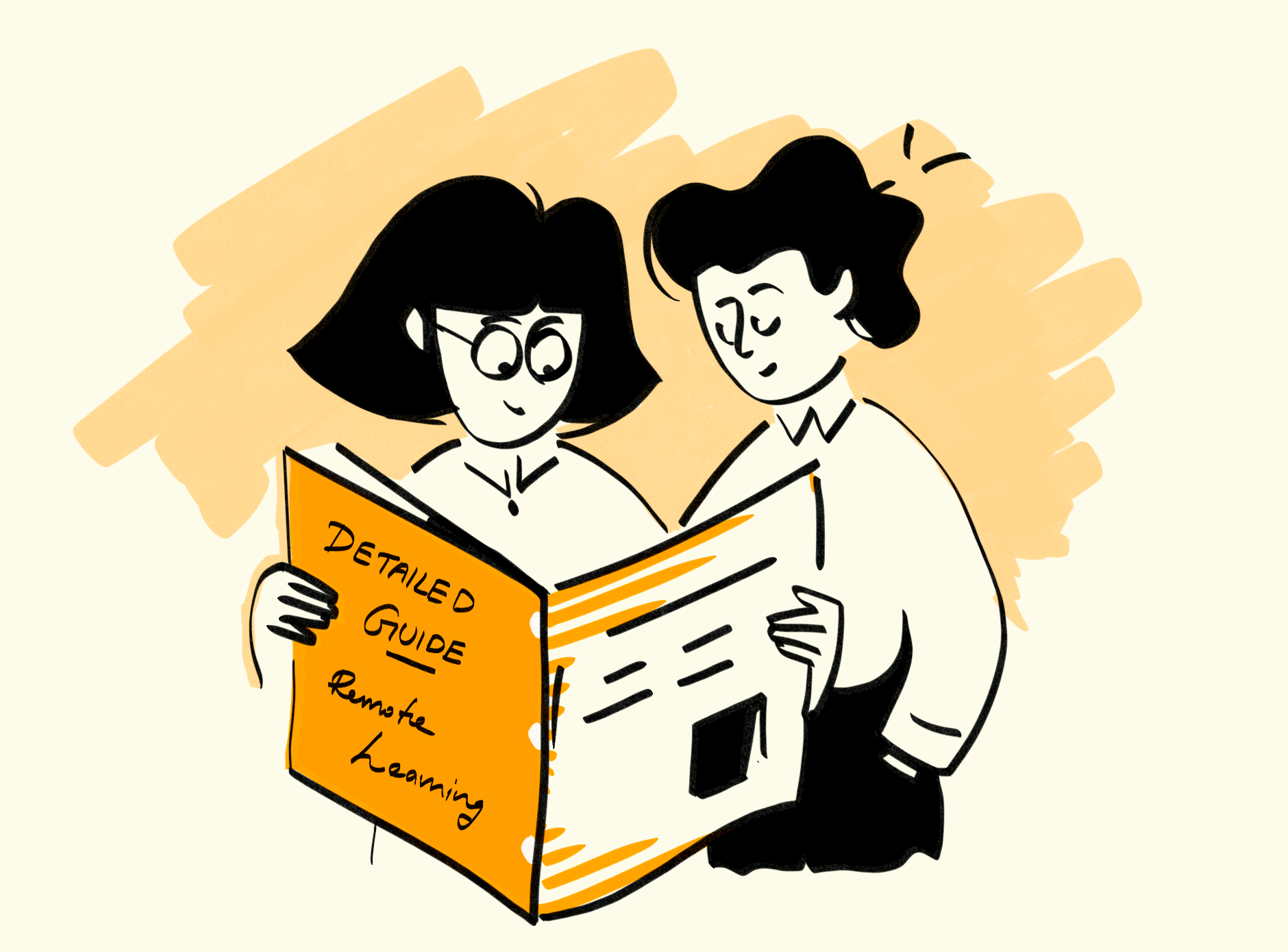



.png)
.webp)
